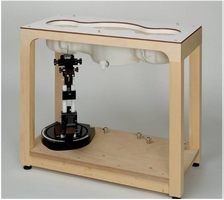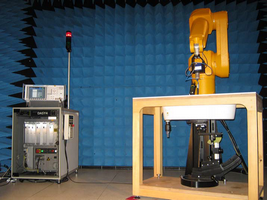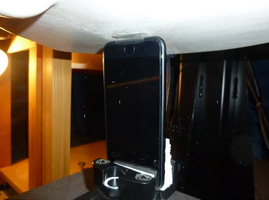How is SAR measured?

(@DR)
SAR measurement requires the use of a measurement sensor probe in laboratory environment. This measurement is not possible on living beings, therefore a dummy a phantom called Specific Anthropomorphic Mannequin (SAM) is used to simulate the human body. SAM phantom is constituted of two half of head-shaped tanks for the head SAR assessment and a flat tank for the trunk and limbs SAR. SAM phantom are is filled with a homogeneous liquid to simulate human tissue, in particular for heating.

The determination of the SAR requires the use of a measurement sensor, which makes it impossible to carry out compliance checks on living beings. A dummy is used to simulate the human body. This dummy is head-shaped for the head SAR assessment and is flat for the trunk SAR. It is filled with a homogeneous liquid to simulate human tissue, in particular for heating

To maintain confidence in SAR measurement system and its environment, the performance of the measurement system are verified using calibrated antennas and radiofrequency generator and following procedures defined within international standards. In order to maintain a high quality level on the SAR measurement, the testing laboratory is accredited under ISO 17025 requirement and periodically audited by an accreditation body (COFRAC in France).
The phone is placed in the positions defined by the standards, and emetting at maximum time-averaged power.
The sensors probe assess the head, trunk and limbs exposure by measuring the electric field inside the phantom and then calculating the peak spatial-averaged SAR for over a volume of 10 grams of tissue simulating liquid in the dummy volume
In order to find the maximum SAR value, all phone faces, as well as all technologies, and operating modes, and all frequencies are measured when the phone is emitting at full power. If the phone can operate using several simultaneous emissions, these cases are taken into account when seeking for the maximum SAR value. In this case, assessments by excess are authorized by summing all contributions, assuming that the maximum is are in the same location.
As part of non-compliance checking, usually the tests are not exhaustive and can be set up to quickly identify the configuration that generates maximum exposure.
SAR is measuredusing a mobile phone emitting:
- at its maximum time-averaged power;
- for 100 % of the time;
- for a total duration of 6 minutes.
The SAR values measured by the laboratory are therefore not an indication of the most frequent use case of the phone:
- for voice communications, statistically, the phone only emits for about half the time as it does not emit when the person is listening; furthermore, the average call time is less than 6 minutes;
- for data-oriented use (internet or video), use times are longer, but the phone rarely emits for more than 10 % of the time;
- finally, for all uses, the phone rarely emits at its maximum power. The SAR measurement configuration (maximum power) is only encountered in very special conditions in real life, in particular when the phone is at the limit of coverage (a single bar on the reception icon).

